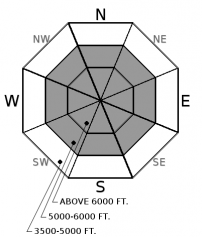| Monday | Monday Night | Tuesday | |
|---|---|---|---|
| Cloud Cover: | Partly sunny with east winds | Clearing and cold | Mostly sunny and mild |
| Temperatures: | 28 to 33 deg. F. | 8 to 13 deg. F. | 30 to 35 deg. F. |
| Wind Direction: | E | SE | S |
| Wind Speed: | 1 to 11 mph with gusts to 21 | 1 to 11 mph | 1 to 11 mph |
| Snowfall: | 0 in. | 0 in. | 0 in. |
| Snow Line: |
Whitefish Range
How to read the forecast
The bountiful storm cycle is over but lingering storm slab instabilities exist, particularly in areas favored during the Friday/Saturday storm. The likelihood of a human triggered storm slab is decreasing but still possible on steep slopes. In areas that harbor a shallow snowpack It remains possible to trigger a very large avalanche on buried weak layers. With the complexity of problems in our snowpack it is best to travel with a conservative mindset until our snowpack adjusts to recent loading.

2. Moderate
?
Above 6500 ft.
2. Moderate
?
5000-6500 ft.
1. Low
?
3500-5000 ft.
- 1. Low
- 2. Moderate
- 3. Considerable
- 4. High
- 5. Extreme
-
Type ?
-
Aspect/Elevation ?

-
Likelihood ?CertainVery LikelyLikelyPossible
 Unlikely
Unlikely -
Size ?HistoricVery LargeLargeSmall

It has been 36, or so, hours since the storm cycle ended Saturday, allowing our snowpack to strengthen and adjust to last weeks substantial load. The likelihood of a human triggered slide is decreasing but still possible at mid and upper elevations. We received few observations during or after the storm and our data from upper elevations is sparse. Therefore traveling with a conservative mindset is the best way to deal with the complexities that our snowpack contain. Our storm slab problem is a surface problem and identifiable by cracking or collapsing under your feet or machine with hand pits identifying this snow structure. Test small inconsequential slopes before committing to larger steeper terrain and continue to use caution around terrain traps, steep rollovers, or in isolated wind-loaded slopes or gullies.
-
Type ?
-
Aspect/Elevation ?

-
Likelihood ?CertainVery LikelyLikelyPossible
 Unlikely
Unlikely -
Size ?HistoricVery LargeLargeSmall

Last weeks storm "woke up" some areas that were harboring a weak snowpack structure, resulting in very large destructive avalanches in the western Flathead Range. Areas that harbor a thin snowpack of less than 4' depth, such as the northern Whitefish Range, are most susceptible to human triggering due to the poor snowpack structure consisting of facets and crust(s). In areas that hold a deep snowpack, poor snow structure can be found near rock outcrops and along the edge of slopes where this slab tapers in depth, with the Skook Chutes in the southern Whitefish Range being a great example of this. Be alert for obvious signs of instability such as collapses or shooting cracks and in areas where a weak snow structure exists it is best to default to lower angle terrain and avoid convex rollovers.
After a week of substantial precipitation and fluctuating temperatures, the past 36 hours of benign weather has been a welcome relief to our snowpack. During the impressive storm cycle, storm slabs were the number one concern throughout our advisory area with instability peaking Friday night/Saturday day (see this observation). Fortunately, storm slabs are a relatively short lived problem with "healing time" generally dependent on the thickness of the slab and the underlying weak layer. Therefore, areas less favored with snowfall Friday/Saturday, such as the Whitefish Range and the eastern Flathead Range along with southern Glacier Park, should stabilize a bit quicker than the Swan and western Flathead Range. Regardless, lingering storm slab instabilities should be expected across our advisory area today and can be identified by cracking in the surface snow with hand pits easily identifying this problem. Unfortunately, the persistent slab problem is a completely different beast and "healing time" is measured in weeks or even months. Observations were limited during the recent storm but persistent slab avalanches were observed in the western Flathead Range (see this observation). Yesterday, we received a report of a large slide on Red Meadow Peak in the northern Whitefish Range which may very well be attributed to the persistent slab problem. This avalanche activity confirms that we still have a weak snowpack structure capable of producing very large destructive avalanches in the Flathead and Whitefish Range along with southern Glacier Park. We have limited data about our snowpack following the recent storm cycle, especially at higher elevations. Therefore we recommend a conservative mindset while dealing with the complexities associated with our pack.
A high pressure ridge will influence our weather leading to valley inversions today. A weak cold front will move into our area from eastern Montana bringing light easterly winds and a few snow showers near the Continental Divide. Tomorrow will be slightly drier and warmer before a weak disturbance moves into our area late Tuesday night.
This advisory applies only to backcountry areas outside established ski area boundaries. This advisory describes general avalanche conditions and local variations always occur. This advisory expires at midnight on the posted day unless otherwise noted. The information in this advisory is provided by the USDA Forest Service who is solely responsible for its content.



























